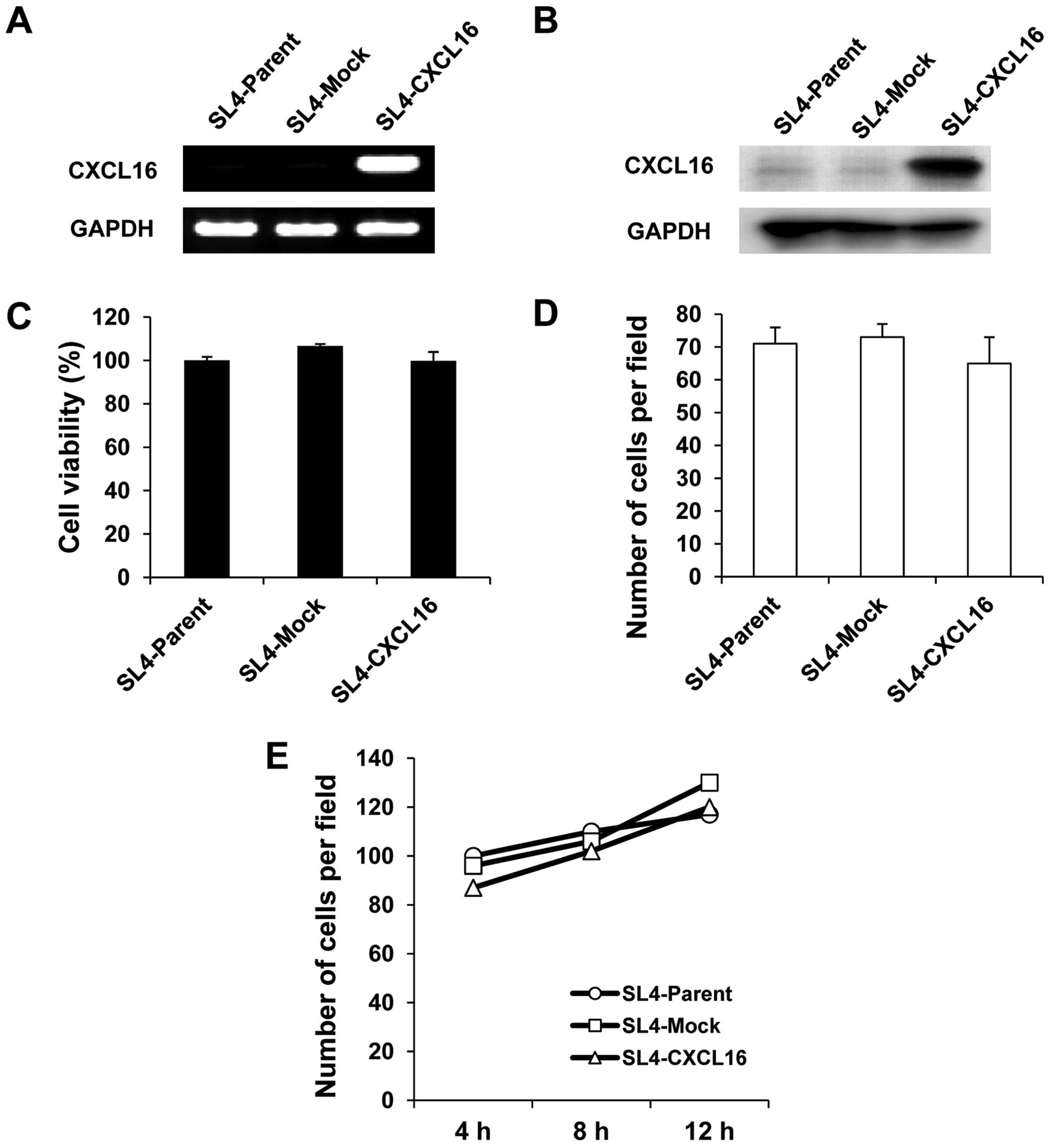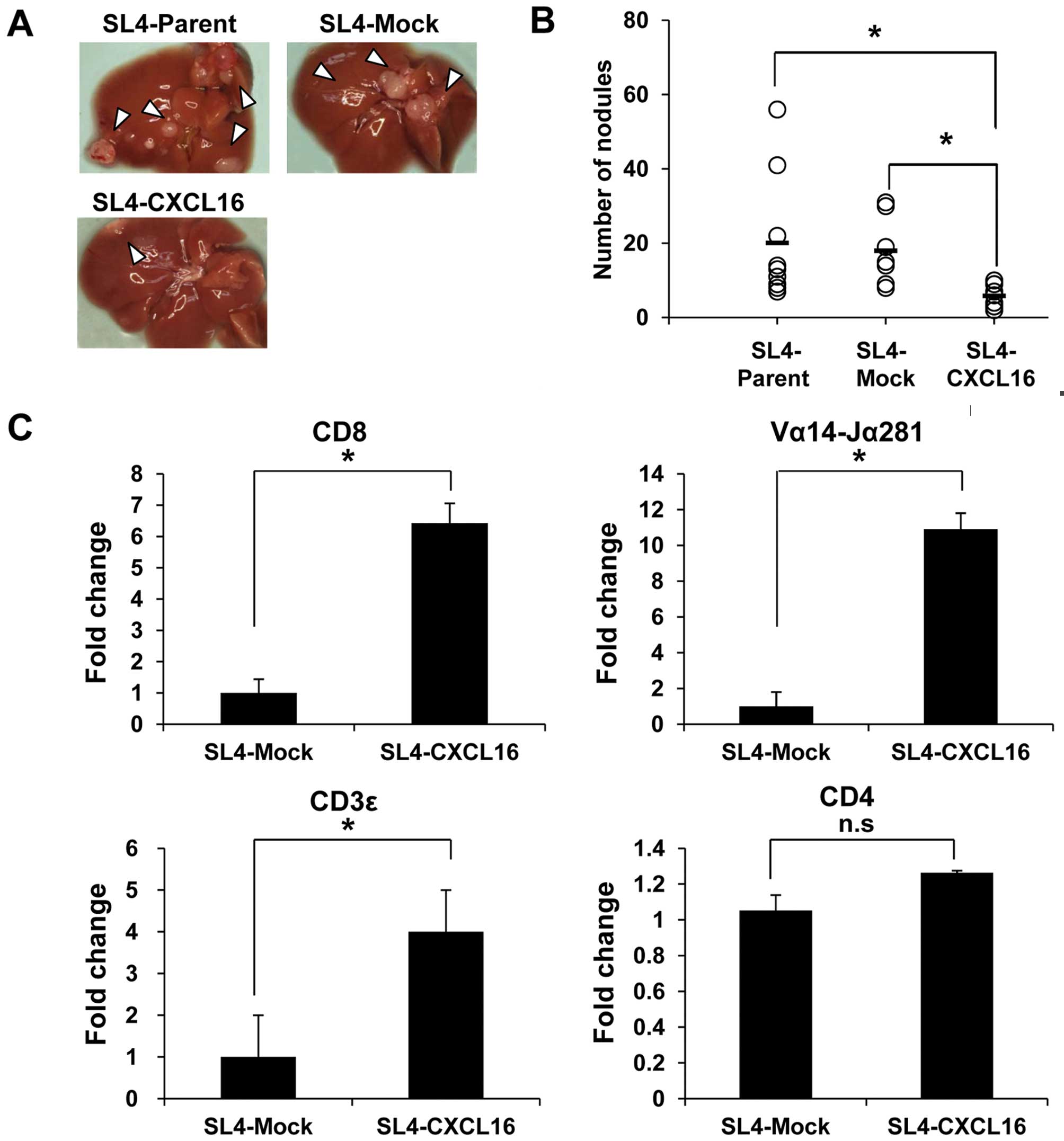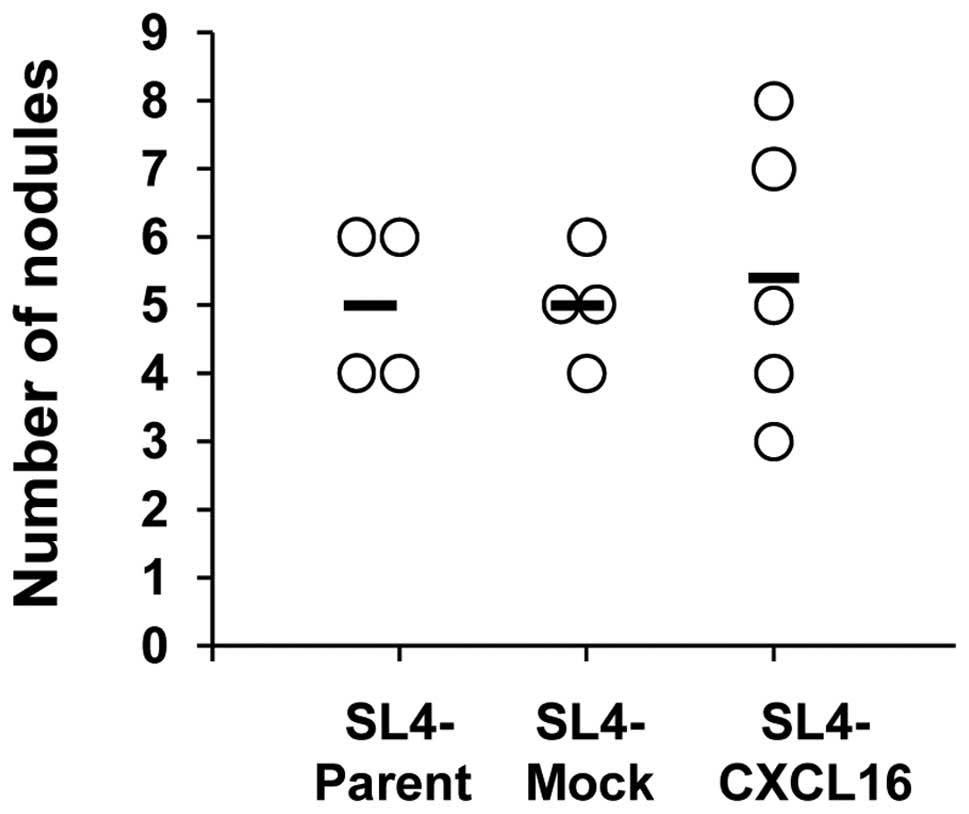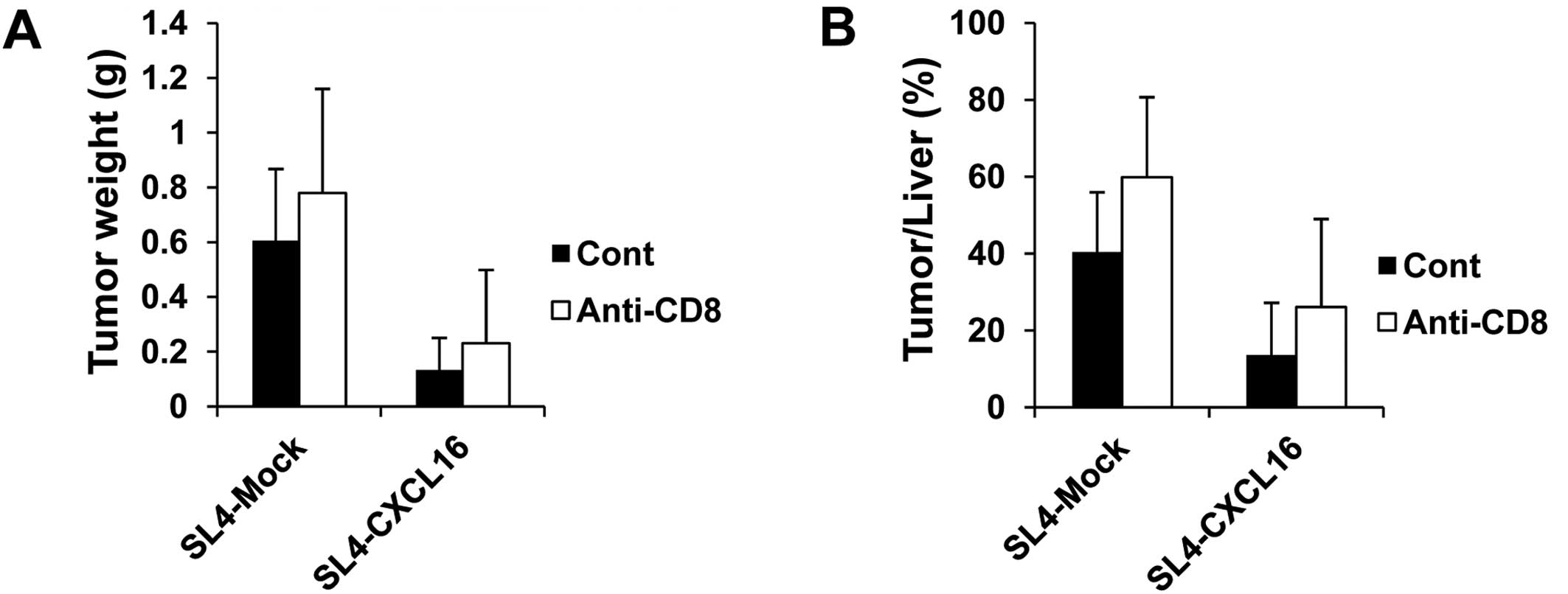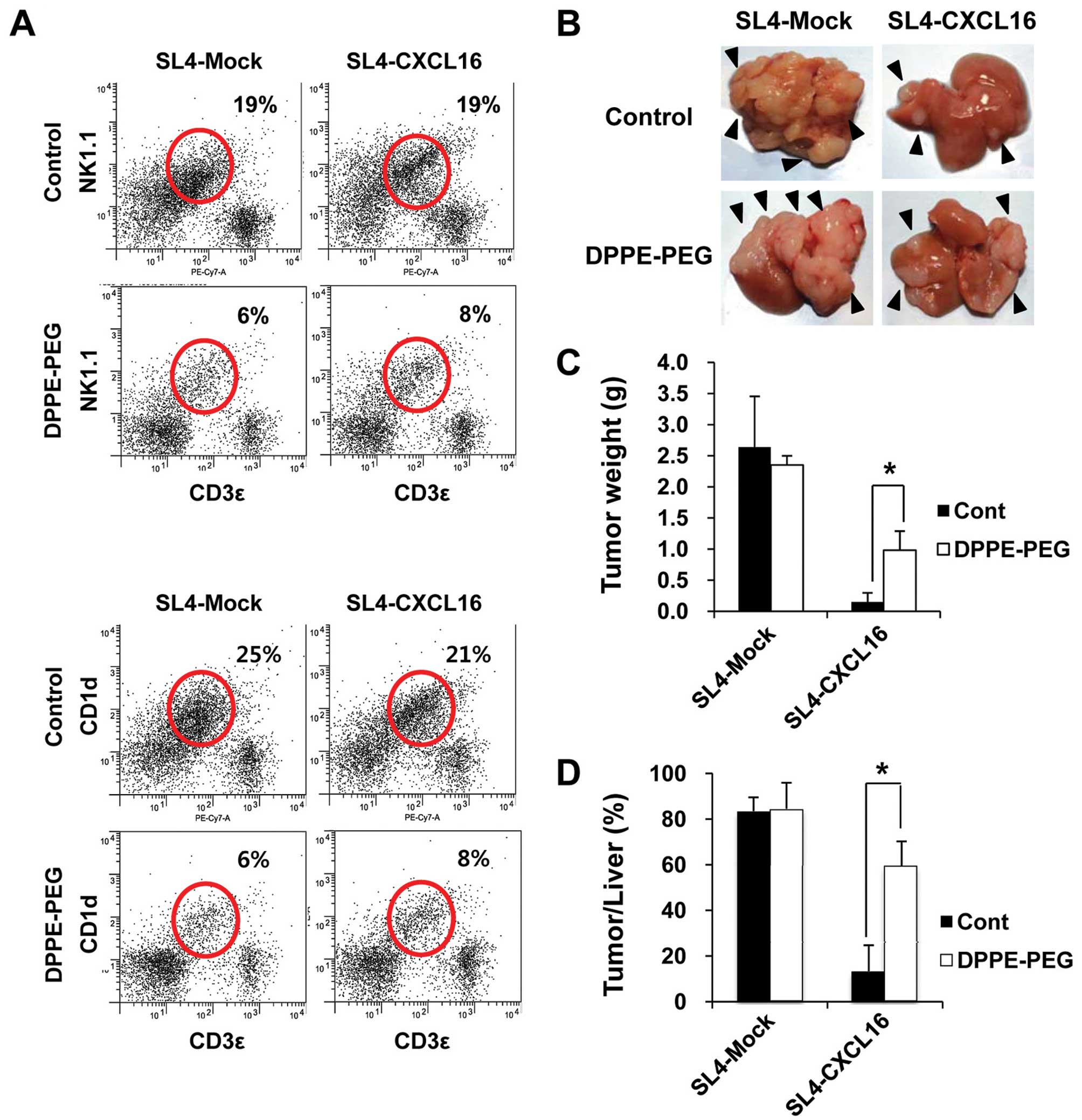Chemokine CXCL16 suppresses liver metastasis of colorectal cancer via augmentation of tumor-infiltrating natural killer T cells in a murine model
- Authors:
- Published online on: December 13, 2012 https://doi.org/10.3892/or.2012.2185
- Pages: 975-982
Abstract
Introduction
Colorectal cancer (CRC) is the second and third most commonly diagnosed cancer in females and males, respectively (1). Approximately 25% of patients with CRC have liver metastasis at initial diagnosis and an additional 50% of patients develop metachronous liver metastasis. Surgery is considered the only curative treatment option for patients with resectable liver metastasis, and the five year survival rate is approximately 35% (2).
It has been shown that chemokines play a role in cancer progression and/or organ-specific metastasis (3–5). Chemokine (C-X-C motif) ligand 16 (CXCL16) is a membrane-bound chemokine that exists in a transmembrane form (TM-CXCL16) and a soluble form (sCXCL16) cleaved by proteolytic enzymes, ADAM10 and ADAM17 (6–11). CXCL16 is expressed in macrophages, dendritic cells, monocytes, and B cells (6–8) as well as in various cancer cell lines and tumor tissues (12–20). CXCL16 has multiple biological functions. TM-CXCL16 can act as a cell adhesion molecule for CXCR6-expressing cells and also as a scavenger receptor for phosphatidylserine and oxidized lipoprotein (7), whereas sCXCL16 is a chemotactic factor for cells expressing its receptor CXCR6 such as activated CD8 T cells, CD4 T cells, and natural killer T (NKT) cells (21,22).
NKT cells are important regulatory immune cells which express NK1.1 and TCR on their surface. Among mouse NKT cells, type I NKT (iNKT) cells such as a Vα14+ NKT express an invariant TCR containing the gene segment Vα14-Jα281 (23). Activated iNKT cells with exogenous glycolipids presented via CD1d molecules are directly cytotoxic to a number of tumor cell lines and play important roles in antitumor and anti-metastatic responses (24–30). Of note, localized iNKT cell infiltration into primary colorectal cancer is associated with a good prognosis (31).
Mouse iNKT cells express high levels of CXCR6 and CXCL16/CXCR6 regulate iNKT cell functions (6,22,31–35). Recent studies have demonstrated that CXCL16 and its receptor CXCR6 are important in the homeostatic distribution of iNKT cells to the liver (7,34,35). In addition to regulating iNKT cell homing, CXCR6 and CXCL16 have been shown to play a critical role in iNKT cell activation in response to glycolipid antigens (7,35). As CXCL16 is expressed as a transmembrane protein on the surface of APCs (7), it is likely that CXCR6 and CXCL16 mediate costimulatory interactions between iNKT cells and glycolipid-presenting cells that modulate activation and effector functions (35).
Previously, we showed that primary tissues highly expressing CXCL16 generated tumor-infiltrating lymphocytes (TIL) and improved the prognosis of CRC patients (15). It has since been reported that CXCL16/CXCR6 expression is involved in the metastasis of various types of cancer (36,37). By contrast, the role of CXCL16 in controlling the metastasis of CRC is unknown. In this study, we investigated the involvement of CXCL16 and metastasis to the liver by CRC cells in an experimental model.
Materials and methods
Cell culture
Colon 38 SL4 cells, a highly metastatic variant of the mouse colon 38 colon cancer cell line, were used. This cell line was maintained in a 1:1 mixture of Dulbecco’s modified Eagle’s medium and Ham’s F-12 medium (DMEM/F12; Invitrogen, Carlsbad, CA, USA) supplemented with 10% fetal calf serum (FCS), 2 mM L-glutamine, 100 U/ml penicillin, and 100 μg/ml streptomycin in a humidified atmosphere of 95% air and 5% CO2 at 37°C.
Transfection of plasmid DNAs
Colon 38 SL4 cells were transfected by Nucleofector™ (Amaxa, Inc., Gaithersburg, MD, USA). Expression vectors (pcDNA 3.1(+) vector; Life Technologies Ltd., Japan) for mouse membrane-bound CXCL16, pcDNA 3.1(+)-CXCL16 were used. DNA was adjusted to 1 μg with empty vectors. After transfection, CXCL16-positive colon 38 SL4 cells were selected by using the antibiotic G148 (Invitrogen). CXCL16-stable expression cells (SL4-CXCL16) and control cells (SL4-Mock) were maintained in DMEM/F12 supplemented with 10% FBS and antibiotics.
Assays of cell growth
Cell growth was quantified using the cell proliferation reagent WST-8 [2-(2-methoxy-4-nitrophenyl)-3-(4-nitrophenyl)-5-(2,4-disulfophenyl)-2H-tetrazolium, monosodium salt] (Dojindo, Kumamoto, Japan). SL4 cells were seeded in 96-well microplates at 2×103 cells/well and incubated 24 h. The medium was then changed (90 μl), 10 μl of WST-8 solution was added, and absorbance was measured at 450 nm.
Migration and adhesion assay
The migration assay was performed in Transwell cell culture chambers (Corning Incorporated Life Sciences, Tewksbury, MA, USA). Polyvinylpyrrolidone-free polycarbonate (PVFP) filters (8.0 μm pore size; Nuclepore, Pleasanton, CA, USA) were pre-coated with Matrigel (BD Biosciences) on the lower part. SL4-Mock or SL4-CXCL16 cell suspension [1×105 cells/100 μl in DMEM/F12 with 0.1% bovine serum albumin (BSA)] was added to the upper compartment and incubated for 4, 8 and 12 h at 37°C. Cells that invaded the lower surface were stained with hematoxylin and eosin and counted under a microscope at ×400 magnification. The adhesion assay was performed in 96-well plates. Triplicate wells were precoated with Matrigel and after removing the Matrigel, SL4-Mock or SL4-CXCL16 cells (1×104 cells/100 μl in DMEM/F12) were incubated for 30 min at 37°C. Cells were aspirated and fixed with 4% formaldehyde approximately 30 min. Adhered cells were stained with hematoxylin for 20 min and counted under the microscope in five predetermined fields at ×400 magnification.
Mice
C57BL/6 female and KSN/slc male 5-week-old nude mice were purchased from Sankyo Lab Service (Hamamatsu, Japan). The study was conducted in accordance with the standards established in the guidelines for the Care and Use of Laboratory Animals of Toyama University.
Experimental liver metastasis of colon 38 SL4 cells
Colon 38 SL4 cells were harvested and resuspended in 1 mM EDTA in phosphate-buffered saline (PBS). For experimental liver metastasis, colon 38 SL4 cells were injected into the intraportal vein. The mice were sacrificed 17 days later and the livers were removed. The increase in tumor weight and the number of tumor colonies in the liver were measured to evaluate tumor metastasis.
CD8 T cell depletion model
Hybridomas producing a 53-6.72 CD8 T cell a specific monoclonal antibody (ATCC, Manassas, VA, USA) were injected intraperitoneally into KSN/slc mice. C57BL/6 female mice were intraperitoneally injected with the ascites fluid of KSN/slc mice 3 days prior to and 3 and 6 days following the inoculation with cancer cells. CD8 T cell depletion was verified by flow cytometry.
NKT cell depletion model
di-palmitoyl-phosphatidylethanolamine polyethyleneglycol (DPPE-PEG) which is used as a reagent of NKT cell depletion (38), purchased from NOF Corporation, was dissolved with saline and injected intraperitoneally (250 μg/50 μl/mouse/day) until the mice were sacrificed.
Real-time PCR
Total-RNA was extracted using an RNeasy Mini kit (Qiagen, Valencia, CA, USA) according to the manufacturer’s directions. First-strand cDNA was synthesized from an RNA template (2 μg) using SuperScript II reverse transcriptase (Invitrogen). The primer sequences are as follows: CD4, 5′-ACACACCTGTGCAAGAAGCA-3′ (forward) and 5′-GCT CTTGTTGGTTGGGAATC-3′ (reverse); CD8, 5′-CTCACCT GTGCACCCTACC-3′ (forward) and 5′-ATCCGGTCCCCTT CACTG-3′ (reverse); Vα14-Jα281, 5′-TGGGAGATACTCAG CAACTCTGG-3′ (forward) and 5′-CAGGTATGACAATCA GCTGAGTCC-3′ (reverse); CD3ɛ, 5′-AACACGTACTTGT ACCTGAAAGCTC-3′ (forward) and 5′-GATGATTATGGC TACTGCTGTCA-3′ (reverse); β-actin, 5′-CTAAGGCCAACC GTGAAAAG-3′ (forward) and 5′-ACCAGAGGCATACAGG GACA-3′ (reverse). Real-time quantitative RT-PCR was performed using a SYBR Premix Ex Taq (Takara Bio, Inc., Otsu, Japan) and Lightcycler nano system (Roche, Pleasanton, CA, USA). All data were normalized to β-actin mRNA.
Lymphocyte isolation and flow cytometry
To isolate lymphocytes from the liver, normal and tumor tissues from the liver were dissected in 20% RPMI-1640 medium. Samples were then further homogenized through wire mesh and mononuclear cells were isolated using a 30% Percoll gradient (GE Healthcare, Little Chalfont, UK) 5 ml, 10X PBS 365 μl, 7% NaHCO3 (Meylon) 65 μl, Heparin 50 μl, and RPMI-1640 10 ml/mouse. Red blood cells were lysed by lysis buffer (NH4Cl solution: 155 mM NH4Cl, 100 mM KHCO3 and 1 mM EDTA-2Na to 1 L with DW, Tris-HCl solution: Trizma 20.6 g was dissolved in 900 ml DW, adjusted pH 7.6 with concentrated HCl, diluted to 1 L with DW mix 900 ml NH4Cl solution and 100 ml Tris-HCl solution, autoclaved, stored at 4°C). To isolate lymphocytes from the spleen, the Percoll gradient was used. For flow cytometry, lymphocytes were first pre-incubated with CD16/32 (2.4G2) mAb and then incubated with a saturating amount of mAb. Antibodies to CD3ɛ (145-2C11), NK1.1 (PK136), and CD1d (RA3-6B2) were purchased from eBioscience (San Diego, CA, USA). The samples were analyzed with the FACSCanto II system (BD Biosciences).
Statistical analysis
Data were analyzed for statistical significance using the Student’s t-test. P-values <0.05 were considered to indicate statistically significant differences. The mean and SD were calculated for all variables.
Results
Stable expression of mouse CXCL16 in mouse colon cancer cells
We initially intended to obtain CXCL16 stable-expression colon 38 SL4 cells (SL4-CXCL16) by the antibiotic selection. Higher CXCL16 expression in SL4-CXCL16 than SL4-Mock cells was confirmed by RT-PCR and western blotting (Fig. 1A and B). Gene introduction into cells often causes various property changes, compared with control cells. Compared with SL4-Mock cells, there was no significant difference in cell growth (Fig. 1C), migration (Fig. 1D) and adhesion (Fig. 1E) in SL4-CXCL16 cells.
Liver metastasis is inhibited by CXCL16-expressing CRC cells
Colon 38 SL4 cells (Parent, Mock and CXCL16) were injected into the intraportal vein to confirm the effect of CXCL16 expression on liver metastasis. Mice were sacrificed on Day 17 and liver metastasis was evaluated by counting nodules. Metastasis into the liver was significantly decreased by SL4-CXCL16 cells (Fig. 2A). Also, the number of nodules was significantly decreased in CXCL16-expressing tumor tissue (Fig. 2B). Since CXCL16 acts as a chemoattractant as well as a cell adhesion molecule for CXCR6-expressing cells (21,22), we conducted a real-time PCR analysis with tumor tissues to confirm which immune cells were recruited to the liver by CXCL16. Among the CXCR6-expressing cells, mRNA levels of CD8 T cell (CD8), NKT cell (Vα14-Jα281) and T cell (CD3ɛ) markers, but not CD4 T cell marker (CD4), were increased 6-, 10- and 4-fold compared with SL4-Mock (Fig. 2C). These results suggested that CXCL16 expression in metastatic tissues recruited CXCR6-expressing cells and then inhibited metastasis to the liver.
Inhibition of liver metastasis by CXCL16 expression is recovered in nude mice
To confirm that CXCR6-expressing T cells are involved in liver metastasis by CXCL16- expressing CRC cells, we performed intraportal vein (i.p.v.) injections of SL4 cells (7.5×104 cells/200 μl PBS/mouse) into nude mice (T cell-deficient mice). Metastasis to the liver did not differ significantly in the SL4-CXCL16 group (Fig. 3). Inhibition of metastasis to the liver by CXCL16 expression was not observed in T cell-deficient mice. These results indicate that T cells mediated the inhibition of liver metastasis by CXCL16.
CD8 T cells are not related to inhibition of liver metastasis by CXCL16
Activated CD8 lymphocytes were recruited to inflamed liver in a mouse model and human patients (39,40). Thus, we examined the role of CD8 T cells in the inhibition of metastasis by CXCL16 in CD8 T cell-depleted mice. To analyze lymphocytes in tumor tissues, we injected SL4-Mock and SL4-CXCL16 cells (1.5×105 cells/200 μl PBS/mouse) and sacrificed the animals at 17 days. In the CD8 T cell-depleted group, liver metastasis was decreased by CXCL16 expression the same as in the control group. Tumor weight and tumor/liver weight percentage were not changed in the CD8 T cell-depleted mice (Fig. 4). These results suggested that CD8 T cells were not related to the inhibition of liver metastasis by CXCL16.
Inhibition of liver metastasis by CXCL16 is recovered in NKT cell-depleted mice
NKT cells present in the liver and the activation of NKT cells regulate tumor surveillance in the liver microenvironment and suppresses liver metastasis (24–30). Thus, we examined whether NKT cells are involved in the inhibition of metastasis by CXCL16. We injected SL4-Mock and SL4-CXCL16 cells (1.5×105 cells/200 μl PBS/mouse) into C57BL/6 mice and DPPE-PEG-treated mice. DPPE-PEG has been reported to be used to inhibit the action of NKT cells (38). The expression of NK1.1 and CD1d in metastatic tumor tissues was measured by FACS analysis. Thus, we used DPPE-PEG as a NKT cell-specific antagonist. As expected, levels of NK1.1 and CD1d were decreased by the DPPE-PEG treatment (Fig. 5A). In addition, the inhibition of liver metastasis by CXCL16 recovered in NKT cell-depleted mice (Fig. 5B). Tumor weight and tumor/liver weight percentage were significantly recovered in NKT cell-depleted mice (Fig. 5C and D). These results indicate that NKT cells are necessary for the inhibition of liver metastasis by CXCL16-expressing cancer cells.
Discussion
Previously, we reported a relationship between the expression of CXCL16 and prognosis of CRC patients, therefore CXCL16 is expected to be a new biomarker for CRC (15). From our report, a recent study found CXCL16 and its receptor CXCR6 to be related to various types of cancer, such as prostate cancer and epithelial ovarian carcinoma, respectively (36,37). However, there is no appropriate treatment for liver metastasis. Therefore, we determined the relationship between CXCL16 and the liver metastasis of CRC cells.
In this study, we investigated the role of cancer-derived CXCL16 and the possibility of gene therapy using CXCL16. We established cells stably overexpressing CXCL16 using the mouse colon 38 SL4 cell line and inoculated SL4-Mock and SL4-CXCL16 cells into the intraportal vein to confirm the effect of CXCL16 expression on liver metastasis. Liver metastasis of CRC cells was decreased by CXCL16 in tumor tissues (Fig. 2A and B). We carried out a microarray assay to confirm the difference between WT and CXCL16-expressing cells. The microarray data showed that there was no significant difference in metastasis-related factors (data not shown). Therefore, we focused on organ-specific immune cells which related to CXCL16. CXCR6, a specific receptor of CXCL16, is expressed in CD4 T cells, CD8 T cells and NKT cells. Real-time PCR data suggested that CD8 T cells and NKT cells were generated in CXCL16-expressing tumor tissues (Fig. 2C).
Since activated CD8 lymphocytes were recruited to inflamed liver in a mouse model and human patients (39,40), we focused on the involvement of CD8 T cells. Thus, we examined the effect of CXCL16 on liver metastasis in CD8 T cell-depleted mice, however, there was no difference from the CD8 T cell-depleted group (Fig. 4). This is probably because among the CD8 T cells, CD8+ Treg cells may be produced and suppress the proliferation and function of effector T cells (41).
Nevertheless, NKT cells make up approximately 1–2% of the lymphocytes in the spleen and account for approximately 30% of lymphocytes in the liver and these NKT cells express high levels of CXCR6. The CXCL16 and CXCR6 axis has been reported to act as a regulator of NKT cell functions such as inhibition of cancer and metastasis (21,34,35). It was reported that neutralization of CXCL16 enhanced metastasis to the liver by B16 melanoma cells, but not lung metastasis (28). These reports suggested that CXCL16 and CXCR6-expressing NKT cells are involved in metastasis to the liver. Therefore, we examined the effect of CXCL16 on the liver metastasis of CRC cells in NKT cell-depleted mice.
Liver metastasis in the control SL4-CXCL16 group was increased by NKT cell depletion (Fig. 5). However, this is an unsettled issue that remains to be clarified in future studies. Markedly, liver metastasis was not increased in the SL4-Mock group, whereas NKT cells were depleted by DPPE-PEG. α-GalCer (NKT cell activator) treatment did not reduce the progression of tumors, as Th1 response by NKT cells was reduced in CXCL16−/− mice (28). It is possible that NKT cells, recruited by CXCL16, are CXCR6 positive and invariant NKT cells which has cytotoxicity to the tumor cells, conversely immature NKT cells did not effect to the metastasis. Further studies are needed to investigate the population and functions of NKT cells augmented by CXCL16-positive CRC compared with CXCL16-negative CRC in the experimental model and clinical samples.
Overexpression of chemokines in cancer can be used to recruit immune cells for antitumor responses and cytotoxicity to cancer cells. It has been reported that CCL21 and CX3CL1 overexpression reduced colon adenocarcinoma growth and inhibited primary cancer and metastasis of neuroblastoma, respectively. However, these results are conducted in an experimental model (42). Reasonable evidence exists that CXCL16 shows the possibility of application in antitumor therapy, as we reported that spontaneous CXCL16 expression is related to the pathology of CRC in clinical cases (15), not only in an experimental model.
Herein we reported that cancer-derived CXCL16 suppresses the liver metastasis of CRC cells by augmenting NKT cells to the metastatic organ. Therefore, our findings indicate that a cancer gene therapy strategy supporting the accumulation of NKT cells by CXCL16, might be an effective therapeutic approach against liver metastasis in CRC.
Acknowledgements
This study was supported by a Grant-in-Aid for Scientific Research (C) (no. 22501042).
References
|
Jemal A, Bray F, Center MM, Ferlay J, Ward E and Forman D: Global cancer statistics. CA Cancer J Clin. 61:69–90. 2011. View Article : Google Scholar | |
|
Timmerman RD, Bizekis CS, Pass HI, Fong Y, Dupuy DE, Dawson LA and Lu D: Local surgical, ablative, and radiation treatment of metastases. CA Cancer J Clin. 59:145–170. 2009. View Article : Google Scholar : PubMed/NCBI | |
|
Zlotnik A, Burkhardt AM and Homey B: Homeostatic chemokine receptors and organ-specific metastasis. Nat Rev Immunol. 11:597–606. 2011. View Article : Google Scholar : PubMed/NCBI | |
|
Koizumi K, Hojo S, Akashi T, Yasumoto K and Saiki I: Chemokine receptors in cancer metastasis and cancer cell-derived chemokines in host immune response. Cancer Sci. 98:1652–1658. 2007. View Article : Google Scholar : PubMed/NCBI | |
|
Koizumi K, Kato S, Sakurai H, Hashimoto I, Yasumoto K and Saiki I: Therapeutics target of CXCR4 and its downstream in peritoneal carcinomatosis of gastric cancer. Front Biosci (Schol Ed). 4:269–276. 2012. View Article : Google Scholar : PubMed/NCBI | |
|
Matloubian M, David A, Engel S, Ryan JE and Cyster JG: A transmembrane CXC chemokine is a ligand for HIV coreceptor Bonzo. Nat Immunol. 1:298–304. 2000. View Article : Google Scholar : PubMed/NCBI | |
|
Shimaoka T, Kume N, Minami M, Hayashida K, Kataoka H, Kita T and Yonehara S: Molecular cloning of a novel scavenger receptor for oxidized low density lipoprotein, SR-PSOX, on macrophages. J Biol Chem. 275:40663–40666. 2000. View Article : Google Scholar : PubMed/NCBI | |
|
Wilbanks A, Zondlo SC, Murphy K, Mak S, Soler D, Langdon P, Andrew DP, Wu L and Briskin M: Expression cloning of the STRL33/BONZO/TYMSTR ligand reveals elements of CC, CXC, and CX3C chemokines. J Immunol. 166:5145–5154. 2001. View Article : Google Scholar : PubMed/NCBI | |
|
Abel S, Hundhausen C, Mentlein R, Schulte A, Berkhout TA, Broadway N, Hartmann D, Sedlacek R, Dietrich S, Muetze B, Schuster B, Kallen KJ, Saftig P, Rose-John S and Ludwig A: The transmembrane CXC-chemokine ligand 16 is induced by IFN-gamma and TNF-alpha and shed by the activity of the disintegrin-like metalloproteinase ADAM10. J Immunol. 172:6362–6372. 2004. View Article : Google Scholar : PubMed/NCBI | |
|
Gough PJ, Garton KJ, Wille PT, Rychlewski M, Dempsey PJ and Raines EW: A disintegrin and metalloproteinase 10-mediated cleavage and shedding regulates the cell surface expression of CXC chemokine ligand 16. J Immunol. 172:3678–3685. 2004. View Article : Google Scholar : PubMed/NCBI | |
|
Ludwig A, Hundhausen C, Lambert MH, Broadway N, Andrews RC, Bickett DM, Leesnitzer MA and Becherer JD: Metalloproteinase inhibitors for the disintegrin-like metalloproteinases ADAM10 and ADAM17 that differentially block constitutive and phorbol ester-inducible shedding of cell surface molecules. Comb Chem High Throughput Screen. 8:161–171. 2005. View Article : Google Scholar | |
|
Gutwein P, Schramme A, Sinke N, Abdel-Bakky MS, Voss B, Obermuller N, Doberstein K, Koziolek M, Fritzsche F, Johannsen M, Jung K, Schaider H, Altevogt P, Ludwig A, Pfeilschifter J and Kristiansen G: Tumoural CXCL16 expression is a novel prognostic marker of longer survival times in renal cell cancer patients. Eur J Cancer. 10:1016–1023. 2008.PubMed/NCBI | |
|
Lu Y, Wang J, Xu Y, Koch AE, Cai Z, Chen X, Galson DL, Taichman RS and Zhang J: CXCL16 functions as a novel chemotactic factor for prostate cancer cells in vitro. Mol Cancer Res. 6:546–554. 2008. View Article : Google Scholar : PubMed/NCBI | |
|
Darash-Yahana M, Gillespie JW, Hewitt SM, Chen YY, Maeda S, Stein I, Singh SP, Bedolla RB, Peled A, Troyer DA, Pikarsky E, Karin M and Farber JM: The chemokine CXCL16 and its receptor, CXCR6, as markers and promoters of inflammation-associated cancers. Plos One. 4:e66952009. View Article : Google Scholar : PubMed/NCBI | |
|
Hojo S, Koizumi K, Tsuneyama K, Arita Y, Cui Z, Shinohara K, Minami T, Hashimoto I, Nakayama T, Sakurai H, Takano Y, Yoshie O, Tsukada K and Saiki I: High-level expression of chemokine CXCL16 by tumor cells correlates with a good prognosis and increased tumor-infiltrating lymphocytes in colorectal cancer. Cancer Res. 67:4725–4731. 2007. View Article : Google Scholar : PubMed/NCBI | |
|
Wågsäter D, Hugander A and Dimberg J: Expression of CXCL16 in human rectal cancer. Int J Mol Med. 14:65–69. 2004. | |
|
Wente MN, Gaida MM, Mayer C, Michalski CW, Haag N, Giese T, Felix K, Bergmann F, Giese NA and Friess H: Expression and potential function of the CXC chemokine CXCL16 in pancreatic ductal adenocarcinoma. Int J Oncol. 33:297–308. 2008.PubMed/NCBI | |
|
Ou DL, Chen CL, Lin SB, Hsu CH and Lin LI: Chemokine receptor expression profiles in nasopharyngeal carcinoma and their association with metastasis and radiotherapy. J Pathol. 210:363–373. 2006. View Article : Google Scholar : PubMed/NCBI | |
|
Held-Feindt J, Rehmke B, Mentlein R, Hattermann K, Knerlich F, Hugo HH, Ludwig A and Mehdorn HM: Overexpression of CXCL16 and its receptor CXCR6/Bonzo promotes growth of human schwannomas. Glia. 56:764–774. 2008. View Article : Google Scholar : PubMed/NCBI | |
|
Seidl H, Richtig E, Tilz H, Stefan M, Schmidbauer U, Asslaber M, Zatloukal K, Herlyn M and Schaider H: Profiles of chemokine receptors in melanocytic lesions: de novo expression of CXCR6 in melanoma. Human Pathol. 38:768–780. 2007. View Article : Google Scholar : PubMed/NCBI | |
|
Kim CH, Kunkel EJ, Boisvert J, Johnston B, Campbell JJ, Genovese MC, Greenberg HB and Butcher EC: Bonzo/CXCR6 expression defines type 1-polarized T-cell subsets with extralymphoid tissue homing potential. J Clin Invest. 107:595–601. 2001. View Article : Google Scholar : PubMed/NCBI | |
|
Kim CH, Johnston B and Butcher EC: Trafficking machinery of NKT cells: shared and differential chemokine receptor expression among V alpha 24(+)V beta 11(+) NKT cell subsets with distinct cytokine-producing capacity. Blood. 100:11–16. 2002.PubMed/NCBI | |
|
Taniguchi M, Harada M, Kojo S, Nakayama T and Wakao H: The regulatory role of Valpha14 NKT cells in innate and acquired immune response. Annu Rev Immunol. 21:483–513. 2003. View Article : Google Scholar : PubMed/NCBI | |
|
Cui J, Shin T, Kawano T, Sato H, Kondo E, Toura I, Kaneko Y, Koseki H, Kanno M and Taniguchi M: Requirement for Valpha14 NKT cells in IL-12-mediated rejection of tumors. Science. 278:1623–1626. 1997. View Article : Google Scholar : PubMed/NCBI | |
|
Kawano T, Cui J, Koezuka Y, Toura I, Kaneko Y, Sato H, Kondo E, Harada M, Koseki H, Nakayama T, Tanaka Y and Taniguchi M: Natural killer-like nonspecific tumor cell lysis mediated by specific ligand-activated Valpha14 NKT cells. Proc Natl Acad Sci USA. 95:5690–5693. 1998. View Article : Google Scholar : PubMed/NCBI | |
|
Toura I, Kawano T, Akutsu Y, Nakayama T, Ochiai T and Taniguchi M: Cutting edge: inhibition of experimental tumor metastasis by dendritic cells pulsed with alpha-galactosylceramide. J Immunol. 163:2387–2391. 1999.PubMed/NCBI | |
|
Smyth MJ, Thia KY, Street SE, Cretney E, Trapani JA, Taniguchi M, Kawano T, Pelikan SB, Crowe NY and Godfrey DI: Differential tumor surveillance by natural killer (NK) and NKT cells. J Exp Med. 191:661–668. 2000. View Article : Google Scholar : PubMed/NCBI | |
|
Cullen R, Germanov E, Shimaoka T and Johnston B: Enhanced tumor metastasis in response to blockade of the chemokine receptor CXCR6 is overcome by NKT cell activation. J Immunol. 183:5807–5815. 2009. View Article : Google Scholar : PubMed/NCBI | |
|
Nakagawa R, Nagafune I, Tazunoki Y, Ehara H, Tomura H, Iijima R, Motoki K, Kamishohara M and Seki S: Mechanisms of the antimetastatic effect in the liver and of the hepatocyte injury induced by alpha-galactosylceramide in mice. J Immunol. 166:6578–6584. 2001. View Article : Google Scholar : PubMed/NCBI | |
|
Smyth MJ, Crowe NY, Pellicci DG, Kyparissoudis K, Kelly JM, Takeda K, Yagita H and Godfrey DI: Sequential production of interferon-gamma by NK1.1(+) T cells and natural killer cells is essential for the antimetastatic effect of alpha-galactosylceramide. Blood. 99:1259–1266. 2002. | |
|
Tachibana T, Onodera H, Tsuruyama T, Mori A, Nagayama S, Hiai H and Imamura M: Increased intratumor Valpha24-positive natural killer T cells: a prognostic factor for primary colorectal carcinomas. Clin Cancer Res. 11:7322–7327. 2005. View Article : Google Scholar | |
|
Thomas SY, Hou R, Boyson JE, Means TK, Hess C, Olson DP, Strominger JL, Brenner MB, Gumperz JE, Wilson SB and Luster AD: CD1d-restricted NKT cells express a chemokine receptor profile indicative of Th1-type inflammatory homing cells. J Immunol. 171:2571–2580. 2003. View Article : Google Scholar : PubMed/NCBI | |
|
Johnston B, Kim CH, Soler D, Emoto M and Butcher EC: Differential chemokine responses and homing patterns of murine TCR alpha beta NKT cell subsets. J Immunol. 171:2960–2969. 2003. View Article : Google Scholar : PubMed/NCBI | |
|
Geissmann F, Cameron TO, Sidobre S, Manlongat N, Kronenberg M, Briskin MJ, Dustin ML and Littman DR: Intravascular immune surveillance by CXCR6+ NKT cells patrolling liver sinusoids. PLoS Biol. 3:e1132005. View Article : Google Scholar : PubMed/NCBI | |
|
Germanov E, Veinotte L, Cullen R, Chamberlain E, Butcher EC and Johnston B: Critical role for the chemokine receptor CXCR6 in homeostasis and activation of CD1d-restricted NKT cells. J Immunol. 181:81–91. 2008. View Article : Google Scholar : PubMed/NCBI | |
|
Ha HK, Lee W, Park HJ, Lee SD, Lee JZ and Chung MK: Clinical significance of CXCL16/CXCR6 expression in patients with prostate cancer. Mol Med Rep. 4:419–424. 2011.PubMed/NCBI | |
|
Guo L, Cui ZM, Zhang J and Huang Y: Chemokine axes CXCL12/CXCR4 and CXCL16/CXCR6 correlate with lymph node metastasis in epithelial ovarian carcinoma. Chin J Cancer. 30:336–343. 2011. View Article : Google Scholar : PubMed/NCBI | |
|
Lombardi V, Stock P, Singh AK, Kerzerho J, Yang W, Sullivan BA, Li X, Shiratsuchi T, Hnatiuk NE, Howell AR, Yu KO, Porcelli SA, Tsuji M, Kronenberg M, Wilson SB and Akbari O: A CD1d-dependent antagonist inhibits the activation of invariant NKT cells and prevents development of allergen-induced airway hyperreactivity. J Immunol. 184:2107–2115. 2010. View Article : Google Scholar : PubMed/NCBI | |
|
Sato T, Thorlacius H, Johnston B, Staton TL, Xiang W, Littman DR and Butcher EC: Role for CXCR6 in recruitment of activated CD8+ lymphocytes to inflamed liver. J Immunol. 174:277–283. 2005. View Article : Google Scholar : PubMed/NCBI | |
|
Heydtmann M, Lalor PF, Eksteen JA, Hubscher SG, Briskin M and Adams DH: CXC chemokine ligand 16 promotes integrin-mediated adhesion of liver-infiltrating lymphocytes to cholangiocytes and hepatocytes within the inflamed human liver. J Immunol. 174:1055–1062. 2005. View Article : Google Scholar | |
|
Wang RF: CD8+ regulatory T cells, their suppressive mechanisms, and regulation in cancer. Hum Immunol. 69:811–814. 2008. | |
|
Slettenaar VI and Wilson JL: The chemokine network: a target in cancer biology? Adv Drug Deliv Rev. 58:962–974. 2006. View Article : Google Scholar : PubMed/NCBI |



